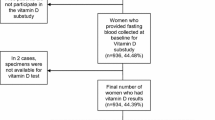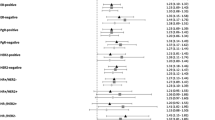Abstract
Purpose
Previous studies have shown that low levels of 25-hydroxyvitamin D (25(OH)D) are associated with a poorer breast cancer survival. The relationship between vitamin D status and breast cancer outcomes is however still debated. The aim of the present study was to investigate the association between 25(OH)D blood levels measured at time of diagnosis and event-free survival (EFS) and overall survival (OS) in a large cohort of patients with early-stage primary invasive breast cancer.
Methods
From April 2008 to April 2013, 25(OH)D status was measured at time of diagnosis in all women operated for early stage primary invasive breast cancer at Rigshospitalet, Copenhagen, Denmark. Associations between 25(OH)D and EFS and OS were investigated using a Cox Proportional hazards model, adjusting for age, disease characteristics, time period, and BMI. Differences in survival were evaluated by hazard ratios (HR).
Results
In the present study, 2510 women with primary invasive breast cancer were included. Women with the lowest 25(OH)D levels (≤ 52 nmol/L) had an inferior EFS with a HR of 1.63 (95% CI 1.21–2.19) compared to women in the third quartile (76–99 nmol/L). Women with the highest 25(OH)D levels (≥ 99 nmol/L) also had an inferior EFS with a HR of 1.37 (95% CI 1.02–1.83). Plotting 25(OH)D status against EFS, the association was inversely J-shaped. For OS, a similar association with 25(OH)D status was observed.
Conclusion
We confirmed previous findings suggesting that a low 25(OH)D status is associated with an inferior breast cancer survival, but unlike previous findings, we found an indication of poorer breast cancer survival also among women with high 25(OH)D levels.


Similar content being viewed by others
References
Holick MF (2007) Vitamin D deficiency. N Engl J Med 357(3):266–281
Feldman D et al (2014) The role of vitamin D in reducing cancer risk and progression. Nat Rev Cancer 14(5):342–357
Bikle DD (2014) Vitamin D metabolism, mechanism of action, and clinical applications. Chem Biol 21(3):319–329
Kim Y, Je Y (2014) Vitamin D intake, blood 25(OH)D levels, and breast cancer risk or mortality: a meta-analysis. Br J Cancer 110(11):2772–2784
Yao S et al (2017) Association of serum level of vitamin d at diagnosis with breast cancer survival: a case-cohort analysis in the pathways study. JAMA Oncol 3(3):351–357
Hatse S et al (2012) Vitamin D status at breast cancer diagnosis: correlation with tumor characteristics, disease outcome, and genetic determinants of vitamin D insufficiency. Carcinogenesis 33(7):1319–1326
Vrieling A et al (2014) Circulating 25-hydroxyvitamin D and postmenopausal breast cancer survival: influence of tumor characteristics and lifestyle factors? Int J Cancer 134(12):2972–2983
Goodwin PJ et al (2009) Prognostic effects of 25-hydroxyvitamin D levels in early breast cancer. J Clin Oncol 27(23):3757–3763
Tretli S et al (2012) Serum levels of 25-hydroxyvitamin D and survival in Norwegian patients with cancer of breast, colon, lung, and lymphoma: a population-based study. Cancer Causes Control 23(2):363–370
Jacobs ET et al (2016) Vitamin D and colorectal, breast, and prostate cancers: a review of the epidemiological evidence. J Cancer 7(3):232–240
Villasenor A et al (2013) Associations of serum 25-hydroxyvitamin D with overall and breast cancer-specific mortality in a multiethnic cohort of breast cancer survivors. Cancer Causes Control 24(4):759–767
Blichert-Toft M, Christiansen P, Mouridsen HT (2008) Danish Breast Cancer Cooperative Group–DBCG: history, organization, and status of scientific achievements at 30-year anniversary. Acta Oncol 47(4):497–505
Christiansen P et al (2016) Danish Breast Cancer Cooperative Group. Clin Epidemiol 8:445–449
Ejlertsen B et al (2018) Forty years of landmark trials undertaken by the Danish Breast Cancer Cooperative Group (DBCG) nationwide or in international collaboration. Acta Oncol 57(1):3–12
Elston CW, Ellis IO (2002) Pathological prognostic factors in breast cancer. I. The value of histological grade in breast cancer: experience from a large study with long-term follow-up. C. W. Elston & I. O. Ellis. Histopathology, 1991; 19; 403–410. Histopathology 41(3a):151–152 (discussion 152–153)
Maunsell Z, Wright DJ, Rainbow SJ (2005) Routine isotope-dilution liquid chromatography-tandem mass spectrometry assay for simultaneous measurement of the 25-hydroxy metabolites of vitamins D2 and D3. Clin Chem 51(9):1683–1690
Hojskov CS, Heickendorff L, Moller HJ (2010) High-throughput liquid-liquid extraction and LCMSMS assay for determination of circulating 25(OH) vitamin D3 and D2 in the routine clinical laboratory. Clin Chim Acta 411(1–2):114–116
Rejnmark L et al (2011) Determinants of plasma PTH and their implication for defining a reference interval. Clin Endocrinol (Oxf) 74(1):37–43
Phinney KW (2008) Development of a standard reference material for vitamin D in serum. Am J Clin Nutr 88(2):511S–512S
Carter GD et al (2004) Measurement of Vitamin D metabolites: an international perspective on methodology and clinical interpretation. J Steroid Biochem Mol Biol 89–90(1–5):467–471
Gail MH et al (2016) Calibration and seasonal adjustment for matched case-control studies of vitamin D and cancer. Stat Med 35(13):2133–2148
Harrell FE, Lee KL (1986) Verifying assumptions of the Cox proportional hazards model. In: Proceedings of the eleventh annual SAS Users group international conference, Cary, NC, pp 823–828
Piura E et al (2009) Serum 1-OH vitamin D (D) and prognosis of postmenopausal breast cancer (BC) patients: NCIC-CTG MA14 trial. J Clin Oncol 27(15S):534–534
Keum N, Giovannucci E (2014) Vitamin D supplements and cancer incidence and mortality: a meta-analysis. Br J Cancer 111(5):976–980
Manson JE et al (2019) Vitamin D supplements and prevention of cancer and cardiovascular disease. N Engl J Med 380(1):33–44
Durup D et al (2012) A reverse J-shaped association of all-cause mortality with serum 25-hydroxyvitamin D in general practice: the CopD study. J Clin Endocrinol Metab 97(8):2644–2652
Zittermann A et al (2012) Vitamin D deficiency and mortality risk in the general population: a meta-analysis of prospective cohort studies. Am J Clin Nutr 95(1):91–100
Sempos CT et al (2013) Is there a reverse J-shaped association between 25-hydroxyvitamin D and all-cause mortality? Results from the U.S. nationally representative NHANES. J Clin Endocrinol Metab 98(7):3001–3009
Melamed ML et al (2008) 25-Hydroxyvitamin D levels and the risk of mortality in the general population. Arch Intern Med 168(15):1629–1637
Durup D et al (2015) A reverse J-shaped association between serum 25-hydroxyvitamin D and cardiovascular disease mortality: the CopD study. J Clin Endocrinol Metab 100(6):2339–2346
Robsahm TE, Schwartz GG, Tretli S (2013) The inverse relationship between 25-hydroxyvitamin D and cancer survival: discussion of causation. Cancers (Basel) 5(4):1439–1455
Hu K et al (2018) Circulating vitamin D and overall survival in breast cancer patients: a dose-response meta-analysis of cohort studies. Integr Cancer Ther 17(2):217–225
Cao Y et al (2018) Vitamin D aggravates breast cancer by inducing immunosuppression in the tumor bearing mouse. Immunotherapy 10(7):555–566
Hofmann JN et al (2010) long-term variation in serum 25-hydroxyvitamin D concentration among participants in the prostate, lung, colorectal, and ovarian cancer screening trial. Cancer Epidemiol Biomarkers Prev 19(4):927–931
Funding
This work was funded by a grant from the Danish Cancer Society (Grant No. R124-A7440-15-S2).
Author information
Authors and Affiliations
Corresponding author
Ethics declarations
Conflicts of interest
The authors claim no potential conflicts of interest.
Ethical approval
The study was approved by the Danish Data Protection Agency, no. 2012-58-0004 and by the Danish Patient Safety Authority, no. 3-3013-1986/1.
Informed consent
The present study is an epidemiological study approved by the Danish Data Protection Agency and by the Danish Patient Safety Authority. Data is only presented in anonymized form. Informed consent is according to Danish law not mandatory for this kind of study.
Additional information
Publisher's Note
Springer Nature remains neutral with regard to jurisdictional claims in published maps and institutional affiliations.
Electronic supplementary material
Below is the link to the electronic supplementary material.
Rights and permissions
About this article
Cite this article
Kanstrup, C., Teilum, D., Rejnmark, L. et al. 25-Hydroxyvitamin D at time of breast cancer diagnosis and breast cancer survival. Breast Cancer Res Treat 179, 699–708 (2020). https://doi.org/10.1007/s10549-019-05486-4
Received:
Accepted:
Published:
Issue Date:
DOI: https://doi.org/10.1007/s10549-019-05486-4




